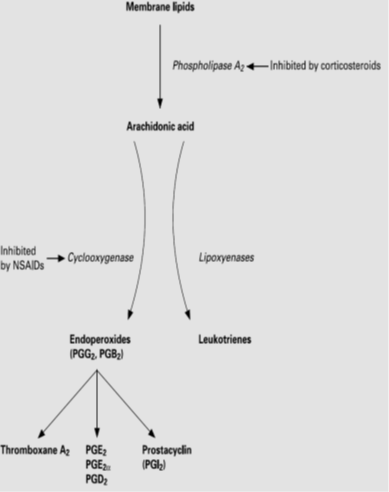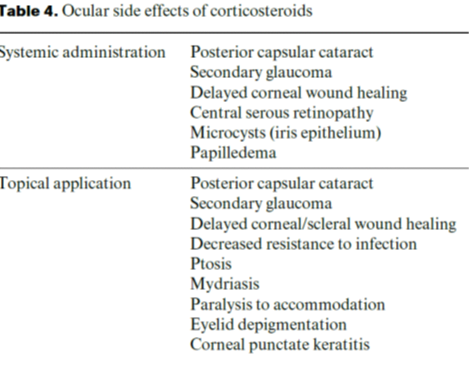Ocular uses of Glucocorticoids
Steroids in ophthalmology à to suppress inflammation, reduce symptoms and minimize scarring.
- steroidal preparations including fluorometholone, prednisolone acetate, prednisolone phosphate and dexamethasone phosphate

The effects of corticosteroids on ocular tissues include:
– reduction of the cellular immune response;
– reduction of inflammatory vascular permeability;
– stabilization of the blood-aqueous barrier;
– limitation of fibrinoid exudation;
– inhibition of fibroblast transdifferentiation;
– inhibition of epithelial proliferation;
– inhibition of inflammatory corneal neovascularization;
– retardation of wound healing;
– elevation of intraocular pressure;
– induction of cataract.
- Inhibit chemotactic leukocyte migration
An important aspect of the corticosteroid anti-inflammatory effect is modulation of the synthesis and release of pro-inflammatory mediators by modulation of gene transcription. Such biochemical mediators include cytokines, TNF, tachykinins, nitric oxide, platelet-activating factor and eicosanoids. Synthesis of pro- inflammatory leukotrienes is pathophysiologically dependent on phospholipase A2 à inhibited by glucocorticoids.
steroids in eye disease
(i)Steroid Drops.
a. External eye disease – Used in allergic eye disease and severe blepharoconjunctivitis only when alternative and adjunctive medicines (mast cell inhibitors, anti-histamines, non-steroidal anti-inflammatories) have failed to control symptoms.
b. Severe cases of idiopathic anterior uveitis may require periocularly injected or systemically applied corticosteroids.
c. Post-operative intraocular surgery à anti-inflammatory effect of corticosteroid eye drops is regarded to be beneficial after surgical procedures like cataract extraction.
d. Keratitis (combined with antiviral therapy in Herpetic eye disease, with antibiotic in bacterial ulcer).
(ii) Steroid Creams (Hydrocortisone 0.5%, 1%) for periocular eczema.
(iii) Steroid Ointmentsà severe anterior uveitis overnight.
(iv) Depot steroid injections into the eye for macular oedema secondary to retinal vein occlusion; diabetic retinopathy intolerant or resistant to antiVEGF therapy.
(v) Subconjunctival injection à shown to be effective in episcleritis, scleritis and anterior uveitis.
(vi) Systemic steroids à temporal arteritis, scleritis, retinitis and posterior segment infections (combined with local and systemic anti-infective agents).

Corticosteroid-Induced Glaucoma
An increase in intraocular pressure will be found in approximately 30% of individuals with an average rise of 10 mm Hg.
Secondary glaucoma due to corticosteroids can be induced by any route of administration
Pressure changes are completely reversible when treatment is discontinued. However, irreversible optic nerve damage may result from prolonged secondary hypertension.
Corticosteroid-Induced Cataract
Posterior subcapsular cataract (PSC) as a complication of both topical and systemic corticosteroid therapy
loteprednol Etabonate Ophthalmic Gel) 0.38% – 25 Feb, 2019 à For The Treatment Of Postoperative Inflammation And Pain Following Ocular Surgery
